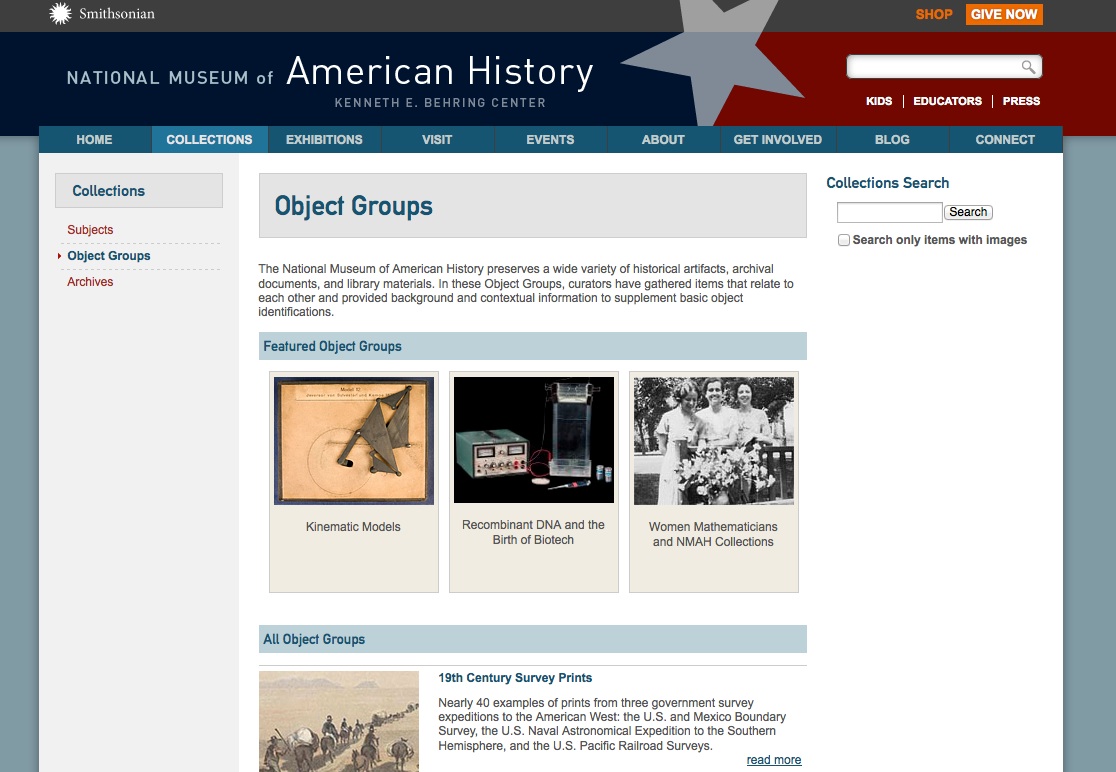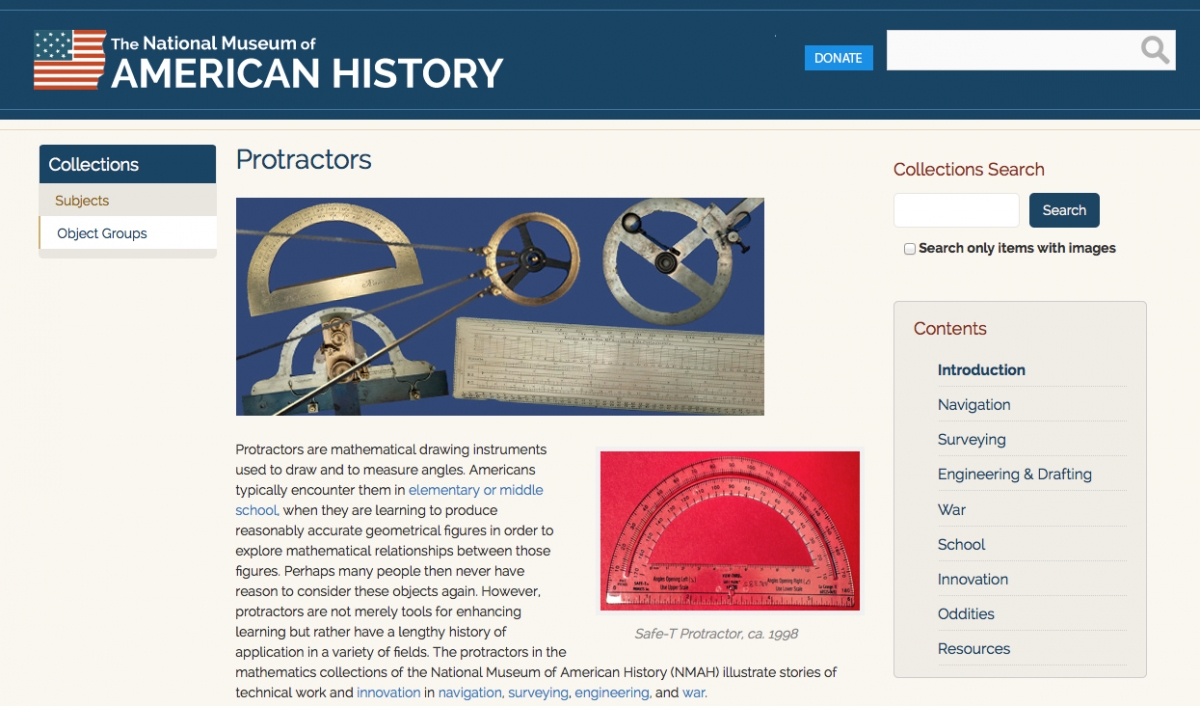- About MAA
- Membership
- MAA Publications
- Periodicals
- Blogs
- MAA Book Series
- MAA Press (an imprint of the AMS)
- MAA Notes
- MAA Reviews
- Mathematical Communication
- Information for Libraries
- Author Resources
- Advertise with MAA
- Meetings
- Competitions
- Programs
- Communities
- MAA Sections
- SIGMAA
- MAA Connect
- Students
- MAA Awards
- Awards Booklets
- Writing Awards
- Teaching Awards
- Service Awards
- Research Awards
- Lecture Awards
- Putnam Competition Individual and Team Winners
- D. E. Shaw Group AMC 8 Awards & Certificates
- Maryam Mirzakhani AMC 10 A Awards & Certificates
- Two Sigma AMC 10 B Awards & Certificates
- Jane Street AMC 12 A Awards & Certificates
- Akamai AMC 12 B Awards & Certificates
- High School Teachers
- News
You are here
Online Museum Collections in the Mathematics Classroom – NMAH Object Groups
Since 2012, the Smithsonian's National Museum of American History (NMAH) has organized online collections records into “object groups.” The term is a little obscure, but the underlying idea is that objects that have some sort of common bond are cataloged thoroughly and brought together on one website, as if they were in an encyclopedia of apparatus relevant to American history. NMAH staff members and, sometimes, volunteers supply overview text for each category of object to help visitors understand what they are seeing, and they additionally provide resources for further information. Some of the groups are thematic, such as Arithmetic Teaching Apparatus or Women Mathematicians whose lives are documented in the Museum's collections. Most of the object groups, though, focus on one type of artifact. This characteristic makes them particularly appealing to those museum visitors, such as collectors and other enthusiasts, who care about only one thing but care about that one thing very much. The object groups can also help users identify historical items they have found in their own homes, workplaces, or academic institutions. At the same time, the online format allows Museum staff to point out commonalties between categories of objects, such as Gunter scales, English-style sectors, and slide rules, all of which are used to perform calculations with logarithmic scales.

A screen shot of the home page for NMAH's object groups, preserved October 8, 2014, shows two of the mathematics groups: Kinematic Models and Women Mathematicians.
A wide variety of objects from NMAH's vast collections are included, with mathematical items especially well represented. At least one “treasure” from most of the mathematics object groups is also highlighted in Convergence:
- Abaci & Numeral Frames – Modern Chinese Abacus
- Adders – Troncet Arithmographe Owned by Daniel Draper
- Adding Machines – Jean Lepine’s Stylus-Operated Adding Machine
- Adding Machines – Thomas Hill's Patent Model for a Key-Driven Adding Machine
- Arithmetic Teaching Apparatus – Add-A-Count Scale for Teaching Arithmetic
- Bookkeeping Machines – National Class 3000 Bookkeeping Machine
- Calculating Machines – Frederick A. P. Barnard's Calculating Machine
- Cash & Credit Registers – Model Cash Register Designed by the Ritty Brothers
- Charter Members of MAA – Geometric Model by Harry Wheeler
- Counters – Moffett Register for Recording Alcohol Sales
- Dividers & Drawing Compasses – Maurice Kidjel's Ratio Cali-Pro
- Electronic Calculators (Desktop) – Wang Loci-2 Programmable Calculator
- Electronic Calculators (Handheld) – Hewlett-Packard HP28S from the AMS Centennial Meeting
- Ellipsographs – Keuffel & Esser Trammel Ellipsograph
- Flowcharting Templates – RCA Flowcharting Template
- Geometric Models – Dissected Rhombic Dodecahedron by A. Harry Wheeler
- Geometric Models – Elongated Pentagonal Pyramid
- Geometric Models – Jullien Models for Descriptive Geometry
- Geometric Models – Paper Model of Elliptic Paraboloid by Brill
- Geometric Models – Thermodynamic Surface by Richard P. Baker
- Geometric Models – Transformable Plane Dissections by A. Harry Wheeler
- Geometric Models – Wire Frame for Soap Film Minimal Surface by Brill
- Kinematic Models – Hypotrochoid Kinematic Model by M. Schilling
- Mathematical Charts & Tables – Number Line Owned by Andrew Gleason
- Mathematical Paintings – Crockett Johnson's Mathematical Paintings
- Mechanical Integrators and Differential Analyzers – Product Integraph by Vannevar Bush and Colleagues
- Metric System Demonstration Apparatus – Demonstration Metric Grain Measures
- Pantographs – Coradi Suspension Pantograph
- Parallel Rules – Captain Field's Improved Parallel Rule
- Pens & Pencils – Rubik's Cube Museum Promotional Pen
- Planimeters – Polar Planimeter Invented by Jacob Amsler
- Protractors – Japanese Protractor for the 1876 World's Fair
- Punch Cards – Factor Stencil Punch Cards
- Scale Rules – Nels Ockerlund's Patent Model for a Combination Ruler
- Sectors – Sector from Jesse Ramsden's Workshop
- Sets of Drawing Instruments – Early Modern Drawing Instruments
- Slide Rules – Raymond Clare Archibald's Slide Rule
- Spherometers – Grunow Spherometer
- Tabulating Equipment – Statistical Tabulator of Benjamin Wood
- Teaching Machines & Mechanical Learning – B. F. Skinner’s Arithmetic Teaching Machine
- Triangles & Squares – Blackboard-Sized Triangles
- Trigonometry in the Plane – Trigonometer for Use with World War II Artillery
- Trigonometry on the Sphere – Model of Spherical Triangle by A. Harry Wheeler
- Women in Mathematics – Objects Related to Women Mathematicians
- Women Teaching & Learning Mathematics in the United States – Boole Senior Blocks Designed by Edith Dummer Mintzer
Each object group has a home page with a general overview. Unless the group is very small (a dozen or so items), a Contents box on the right side provides links to pages for different forms of the object. For instance, the Adding Machines are divided into those that were operated with a stylus, those that had full keyboards (by Felt & Tarrant, by Burroughs, and by other manufacturers), those that had ten keys or fewer, and those that were finger-operated. While most of the groups provide descriptions of about 60 objects, some of the groups are very large, with hundreds of instruments; examples include Adding Machines, Calculating Machines, and Slide Rules. The Slide Rules group is unusual in that it is indexed several different ways to make it easier to locate specific models of slide rules: by shape or form, by manufacturer, by the materials from which they were made, and by purpose. Most of the groups show tools of engineering, business, and education, but the Mathematical Paintings of Crockett Johnson are unique for representing geometrical principles in which Johnson found aesthetic value. Each group has a page of Resources for further reading.

The home page for the Protractors Object Group, preserved October 27, 2014, shows several different functions for protractors in the Contents listing.
Clicking on the name of an object at the bottom of a section page leads to the online catalog record for that object. These are typically thorough descriptions that include references. Clicking on the thumbnail image next to the description calls up a larger version of the image, with tools for zooming in and out from the image and a link to a higher-quality image suitable for downloading to use for lecture illustrations and the like. Note that the Smithsonian negative number is in the URL for this image, as well as in the file name of the downloaded file. Since the Smithsonian Institution is partially funded by the U.S. government, its online materials are in the public domain and generally there are no copyright restrictions on digitized images used for noncommercial purposes. Nonetheless, users should include a credit line when using images in presentations and publications and provide two copies of published works to the Smithsonian Institution Libraries. Additional photographs may appear at the bottom of the object's catalog record page. The pages for individual objects mimic social media in that the Museum also allows visitors to write comments at the bottom of the page; comments and questions are passed on to the appropriate curator.
Object groups continue to be added to the NMAH website, so readers should make it a habit to visit the site (https://www.si.edu/spotlight/) to check for updates.
Amy Ackerberg-Hastings (University of Maryland University College) and Amy Shell-Gellasch (Montgomery College), "Online Museum Collections in the Mathematics Classroom – NMAH Object Groups," Convergence (December 2014)




